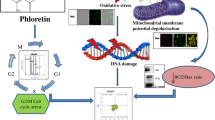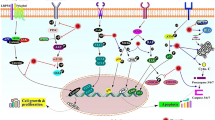Abstract
Purpose
Abnormal acetylation modification is a common epigenetic change in tumorigenesis and is closely related to the progression of colorectal cancer (CRC). Our previous studies have suggested that black raspberry (BRB) anthocyanins have a significant chemopreventive effect against CRC. This study investigated whether protein acetylation plays an important role in BRB anthocyanins-mediated regulation of CRC progression.
Methods
We used the AOM-induced CRC mouse model and the CRC cell lines SW480 and Caco-2 to explore the potential role of acetylation of histone H4 and NF-κB signaling pathway-related proteins (non-histone proteins) in the antitumor process mediated by BRB anthocyanins. The expression of related proteins was detected by western blot. ROS level was detected by immunofluorescence.
Results
BRB anthocyanins affected the acetylation level by down-regulating the expression of Sirtuin1 (SIRT1) and up-regulating the expression of MOF and EP300. The acetylation level of lysine sites on histone H4 (H4K5, H4K12 and H4K16) was increased. Furthermore, following BRB anthocyanins treatment, the expression of ac-p65 was significantly up-regulated and the NF-κB signal pathway was activated, which in turn up-regulated Bax expression and inhibited Bcl-2, cyclin-D1, c-myc and NLRP3 expression to promote CRC cell cycle arrest, apoptosis and relieve inflammation.
Conclusion
The findings suggested that protein acetylation could play a critical role in BRB anthocyanins-regulated CRC development.






Similar content being viewed by others
References
Brenner H, Kloor M, Pox CP (2014) Colorectal cancer. Lancet 383:1490–1502
Dekker E, Tanis PJ, Vleugels JLA et al (2019) Colorectal cancer. Lancet 394:1467–1480
Lao V, Grady W (2011) Epigenetics and colorectal cancer. Nat Rev Gastroenterol Hepatol 8:686–700
Jung G, Hernandez-Illan E, Moreira L et al (2020) Epigenetics of colorectal cancer: biomarker and therapeutic potential. Nat Rev Gastroenterol Hepatol 17:111–130
Schizas D, Mastoraki A, Naar L et al (2020) Histone deacetylases (HDACs) in gastric cancer: an update of their emerging prognostic and therapeutic role. Curr Med Chem 27:6099–6111
Wang Y, He J, Liao M et al (2019) An overview of Sirtuins as potential therapeutic target: Structure, function and modulators. Eur J Med Chem 161:48–77
Ming M, Soltani K, Shea CR et al (2015) Dual role of SIRT1 in UVB-induced skin tumorigenesis. Oncogene 34:357–363
Li Y, Chen X, Cui Y et al (2019) Effects of SIRT1 silencing on viability, invasion and metastasis of human glioma cell lines. Oncol Lett 17:3701–3708
Pan JH, Zhou H, Zhu SB et al (2019) Nicotinamide phosphoribosyl transferase regulates cell growth via the Sirt1/P53 signaling pathway and is a prognosis marker in colorectal cancer. J Cell Physiol 234:4385–4395
Sun LN, Zhi Z, Chen LY et al (2017) SIRT1 suppresses colorectal cancer metastasis by transcriptional repression of miR-15b-5p. Cancer Lett 409:104–115
Buhrmann C, Shayan P, Popper B et al (2016) Sirt1 is Required for resveratrol-mediated chemopreventive effects in colorectal cancer cells. Nutrients 8:145
Nakagawa T, Guarente L (2014) SnapShot: sirtuins, NAD, and aging. Cell Metab 20(192–192):e191
Nopparat C, Sinjanakhom P, Govitrapong P (2017) Melatonin reverses H2 O2 -induced senescence in SH-SY5Y cells by enhancing autophagy via sirtuin 1 deacetylation of the RelA/p65 subunit of NF-kappaB. J Pineal Res 63:e12407
Afonina IS, Zhong Z, Karin M et al (2017) Limiting inflammation—the negative regulation of NF-kappaB and the NLRP3 inflammasome. Nat Immunol 18:861–869
Park S, Shin J, Bae J et al (2020) SIRT1 Alleviates LPS-induced IL-1beta production by suppressing NLRP3 inflammasome activation and ROS production in trophoblasts. Cells 9:728
Jeong J-H, Jung H, Lee S-R et al (2010) Anti-oxidant, anti-proliferative and anti-inflammatory activities of the extracts from black raspberry fruits and wine. Food Chem 123:338–344
Yang H, Oh S, Lim S et al (2008) Antiinflammatory activities of Rubus coreanus depend on the degree of fruit ripening. Phytother Res: PTR 22:102–107
Stoner GD (2009) Foodstuffs for preventing cancer: the preclinical and clinical development of berries. Cancer Prev Res 2:187–194
Stoner GD, Wang LS, Casto BC (2008) Laboratory and clinical studies of cancer chemoprevention by antioxidants in berries. Carcinogenesis 29:1665–1674
Bi X, Fang W, Wang LS et al (2010) Black raspberries inhibit intestinal tumorigenesis in apc1638+/− and Muc2−/− mouse models of colorectal cancer. Cancer Prev Res (Phila) 3:1443–1450
Chen L, Jiang B, Zhong C et al (2018) Chemoprevention of colorectal cancer by black raspberry anthocyanins involved the modulation of gut microbiota and SFRP2 demethylation. Carcinogenesis 39:471–481
Merarchi M, Sethi G, Shanmugam MK et al (2019) Role of natural products in modulating histone deacetylases in cancer. Molecules 24:1047
Xiao T, Guo Z, Bi X et al (2017) Polyphenolic profile as well as anti-oxidant and anti-diabetes effects of extracts from freeze-dried black raspberries. J Funct Foods 31:179–187
Stoner GD, Wang LS, Zikri N et al (2007) Cancer prevention with freeze-dried berries and berry components. Semin Cancer Biol 17:403–410
Li X, Chen L, Gao Y et al (2021) Black raspberry anthocyanins increased the antiproliferative effects of 5-fluorouracil and celecoxib in colorectal cancer cells and mouse model. J Funct Foods 87:104801
Zhang J, Zhang Y, Xiao F et al (2016) The peroxisome proliferator-activated receptor gamma agonist pioglitazone prevents NF-kappaB activation in cisplatin nephrotoxicity through the reduction of p65 acetylation via the AMPK-SIRT1/p300 pathway. Biochem Pharmacol 101:100–111
Yu H, Lin L, Zhang Z et al (2020) Targeting NF-kappaB pathway for the therapy of diseases: mechanism and clinical study. Signal Transduct Target Ther 5:209
Dajee M, Lazarov M, Zhang JY et al (2003) NF-kappaB blockade and oncogenic Ras trigger invasive human epidermal neoplasia. Nature 421:639–643
van Hogerlinden M, Auer G, Toftgard R (2002) Inhibition of Rel/Nuclear Factor-kappaB signaling in skin results in defective DNA damage-induced cell cycle arrest and Ha-ras- and p53-independent tumor development. Oncogene 21:4969–4977
Maeda S, Kamata H, Luo JL et al (2005) IKKbeta couples hepatocyte death to cytokine-driven compensatory proliferation that promotes chemical hepatocarcinogenesis. Cell 121:977–990
Xiao X, Yang G, Bai P et al (2016) Inhibition of nuclear factor-kappa B enhances the tumor growth of ovarian cancer cell line derived from a low-grade papillary serous carcinoma in p53-independent pathway. BMC Cancer 16:582
Jiang T, Jiang D, Zhang L et al (2019) Anagliptin ameliorates high glucose- induced endothelial dysfunction via suppression of NLRP3 inflammasome activation mediated by SIRT1. Mol Immunol 107:54–60
Bolden JE, Peart MJ, Johnstone RW (2006) Anticancer activities of histone deacetylase inhibitors. Nat Rev Drug Discov 5:769–784
Dokmanovic M, Marks PA (2005) Prospects: histone deacetylase inhibitors. J Cell Biochem 96:293–304
Zhang QL, Wang L, Zhang YW et al (2009) The proteasome inhibitor bortezomib interacts synergistically with the histone deacetylase inhibitor suberoylanilide hydroxamic acid to induce T-leukemia/lymphoma cells apoptosis. Leukemia 23:1507–1514
Jha S, Srivastava SY, Brickey WJ et al (2010) The inflammasome sensor, NLRP3, regulates CNS inflammation and demyelination via caspase-1 and interleukin-18. J Neurosci 30:15811–15820
Porcellini E, Laprovitera N, Riefolo M et al (2018) Epigenetic and epitranscriptomic changes in colorectal cancer: diagnostic, prognostic, and treatment implications. Cancer Lett 419:84–95
Baretti M, Azad NS (2018) The role of epigenetic therapies in colorectal cancer. Curr Probl Cancer 42:530–547
Salek Farrokhi A, Mohammadlou M, Abdollahi M et al (2020) Histone deacetylase modifications by probiotics in colorectal cancer. J Gastrointest Cancer 51:754–764
Puar YR, Shanmugam MK, Fan L et al (2018) Evidence for the involvement of the master transcription factor NF-kappaB in cancer initiation and progression. Biomedicines 6:82
Wang DJ, Ratnam NM, Byrd JC et al (2014) NF-kappaB functions in tumor initiation by suppressing the surveillance of both innate and adaptive immune cells. Cell Rep 9:90–103
Newbold A, Falkenberg KJ, Prince HM et al (2016) How do tumor cells respond to HDAC inhibition? FEBS J 283:4032–4046
Roger T, Lugrin J, Le Roy D et al (2011) Histone deacetylase inhibitors impair innate immune responses to Toll-like receptor agonists and to infection. Blood 117:1205–1217
Barneda-Zahonero B, Parra M (2012) Histone deacetylases and cancer. Mol Oncol 6:579–589
Sun Z, Lu W, Lin N et al (2020) Dihydromyricetin alleviates doxorubicin-induced cardiotoxicity by inhibiting NLRP3 inflammasome through activation of SIRT1. Biochem Pharmacol 175:113888
Zhou B, Qiu Y, Wu N et al (2020) FNDC5 attenuates oxidative stress and NLRP3 inflammasome activation in vascular smooth muscle cells via activating the AMPK-SIRT1 signal pathway. Oxid Med Cell Longev 2020:6384803
Acknowledgements
This work was mainly supported by the Grants from National Natural Science Foundation of China (Grants#81272333; #81472821), Liaoning Revitalization Talents Program (#XLYC1807058), Key Grant of Basic Research Liaoning Education Department (LETU#LZD201904) to Bi, X, Disciplinary Construction Project of the College of Mathematics and Statistics, Liaoning University (MSKY202210) to Chen, L. We thank Dr. Alan K. Chang for revising the language of the manuscript.
Author information
Authors and Affiliations
Contributions
XB and LC designed the research. ML and HZ wrote the original manuscript, XB, LC and AC reviewed and edited the manuscript. LC, YL, WP, TM and CN performed the experiments. LC, ZY and XL analyzed the data. All authors read and approved the final manuscript.
Corresponding author
Ethics declarations
Conflict of interest
The authors declare no conflict of interest.
Ethics approval
All animal procedures performed were approved by the Animal Care Committee of the Traditional Chinese Medicine of Liaoning University (No. 21000092017048).
Supplementary Information
Below is the link to the electronic supplementary material.
Rights and permissions
Springer Nature or its licensor holds exclusive rights to this article under a publishing agreement with the author(s) or other rightsholder(s); author self-archiving of the accepted manuscript version of this article is solely governed by the terms of such publishing agreement and applicable law.
About this article
Cite this article
Chen, L., Li, M., Zhou, H. et al. Sirtuin1 (SIRT1) is involved in the anticancer effect of black raspberry anthocyanins in colorectal cancer. Eur J Nutr 62, 395–406 (2023). https://doi.org/10.1007/s00394-022-02989-7
Received:
Accepted:
Published:
Issue Date:
DOI: https://doi.org/10.1007/s00394-022-02989-7




